Voyage to Uchronia by Matali Crasset at Galerie Thaddaeus Ropac
French designer Matali Crasset is showing a series of mysterious hooded furniture at an exhibition in Paris (+ slideshow).
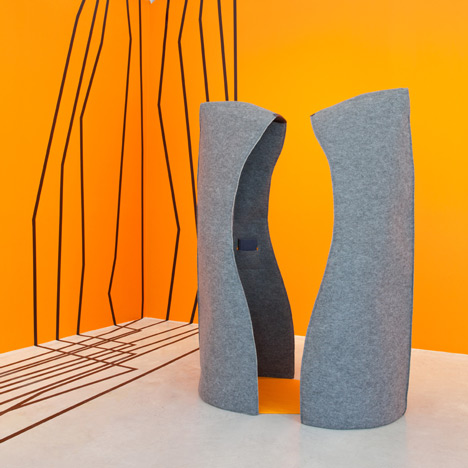
The group of furniture is entitled the Permanents and is designed to evoke the habits and rituals of an imaginary human community.
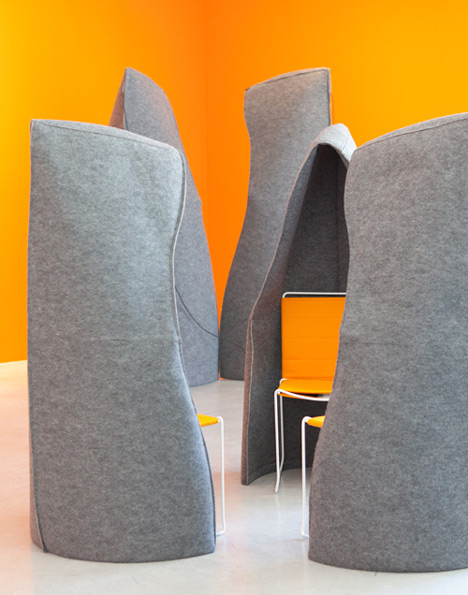
Folded sheets of felt create structures that envelop the body and form hoods overhead.
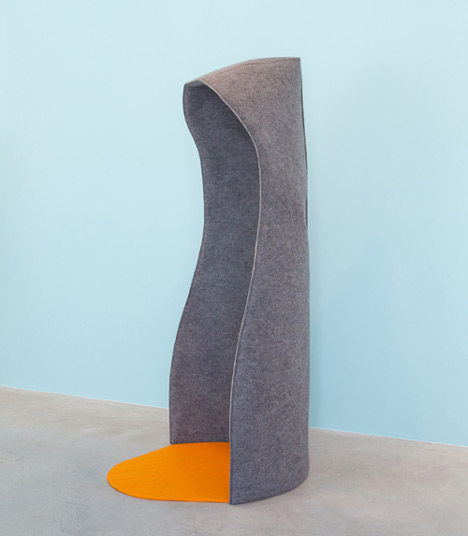
Each piece is given a unique purpose - as a place to lie down, sit or come together - and some incorporate objects including a chair and a wooden bell.
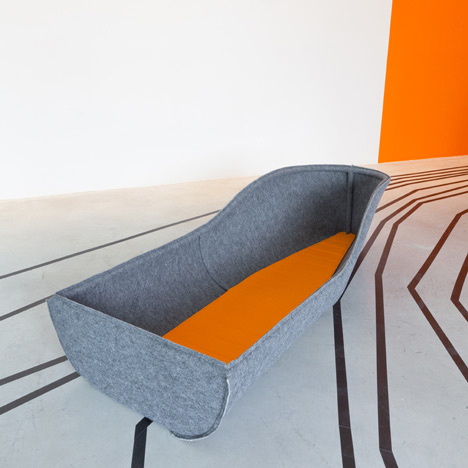
Orange mats or chair coverings inside the felt structures highlight functions and represent the warmth of the body, while the grey shell emphasises its protective quality.
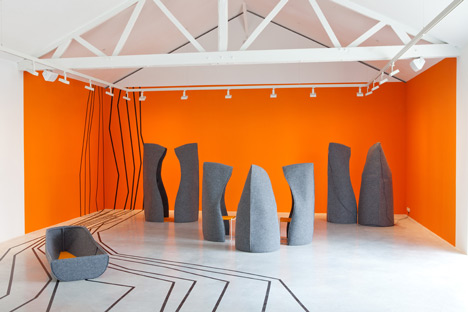
The furniture is being shown at Galerie Thaddaeus Ropac together with a film directed by Matali Crasset and Paris and Berlin-based artist Juli Susin, which shows people wearing coloured versions of the hoods performing a series of rituals on an imagined journey to a mystical mountain.
Crasset says: "I think of the exhibition as a space for introspection. I'm interested in presenting elements of a moving and developing line of thought by using formalizations far removed from my usual practice with the 'exhibition' object."

"I question my own practice as much as I question design in all its entrenchments, by thinking of it as an autonomous activity, detached from any basic premise," she adds. "Thinking, and suggesting hypotheses, is what excites me in this context."
The exhibition continues until 20 July.

Matali Crasset designed a sofa system comprising two removable upholstered chairs and pebble-like cushions that was launched in Milan earlier this year and she has also created a range of products and furniture made from concrete – see all projects by Matali Crasset.
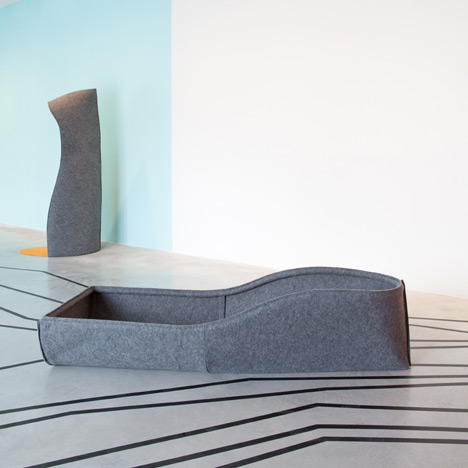
A chair with armrests that extend to form a protective loop around the sitter was popular on Dezeen this week – see all furniture design.
Here's some more information about the exhibition from Galerie Thaddaeus Ropac:
Matali Crasset, Voyage to Uchronia, Pantin
Galerie Thaddaeus Ropac is delighted to be hosting matali crasset’s project Voyage en Uchronie ('Voyage to Uchronia') in our Pantin gallery. Following the exhibition of the blobterre at the Centre Pompidou in 2012, Voyage to Uchronia, crasset’s fifth exhibition at Galerie Thaddaeus Ropac, continues her reflection on experimental environments.
Voyage to Uchronia is a fiction that takes place in a separate time. This exhibition questions notions of utopia and rituals, which are central elements in matali crasset’s practice.
The exhibition is made up of a series of furniture pieces, the Permanents, built around the same structure and a film directed with Juli Susin of the Royal Book Lodge, titled Voyage to Uchronia, salvatico è colui che si salva.
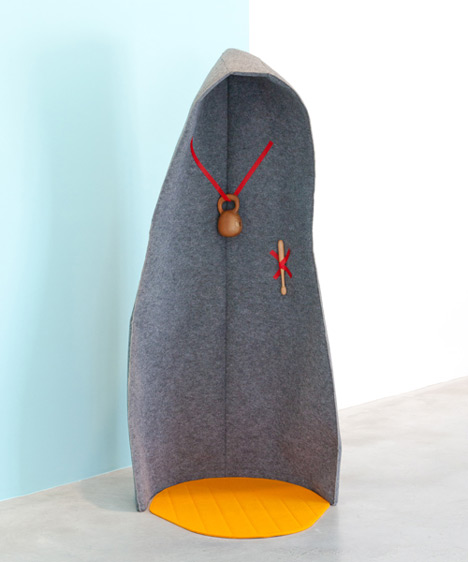
The Permanents
Voyage to Uchronia brings together a group of furniture, the Permanents, that evoke a group of humans and their rituals.
The Permanents are built around a unique form that envelops the body and is present through its various activities. The module partially surrounds the body whilst standing, seated or laying down. The folded form protects the head, inviting us to meditate. The exterior grey color accentuates it’s protective side, the interior has orange areas highlighting an invitation to read, to sit, to lay down, to see, to remember, to listen…
These structures are in their simplest forms, closest to the human being. We recognize in the different elements in this scheme that evoke a primitive life: a chair, a cabinet of curiosities, a portrait gallery, a wooden bell, a puppet, one to lay down in, one used for thinking, for concentrating in and a module to meet others, composed of several Permanents. The pieces are made in felt, a material evoking protection and the unchanging.
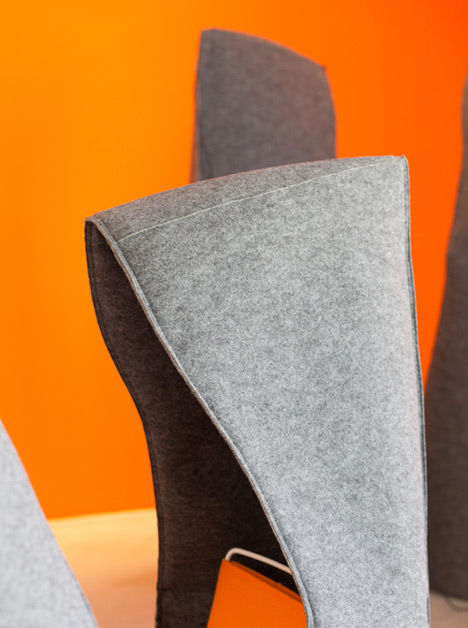
Voyage to Uchronia: salvatico è colui che si salva
This film was born out of a collaboration between matali crasset and Juli Susin realized through his collaborative platform: the Royal Book Lodge. It is their first film together and includes Julia Rublow’s participation.
In the forest where the mystical mathematician Pythagoras lived and died, a tribe carries out imaginary rituals. Against the backdrop of water, air and sun, Uchronia’s universe unfolds, a world born out of a collision of figures and colors.
Do other worlds appear and disappear on the way to ours? What remains? Were the numbers at the origin of forms and colors there before us? This transformation of the Pythagorean question where the origin of our civilization crosses path with the future, is a temporal transgression and colorful introspection that gives birth to the film with a pulsating and hypnotic rhythm.
At the end of the film a herd of wild boar gathered around an airplane evoke Leonardo da Vinci’s metaphor "Salvatico è colui che si salva," which means "Wild he who saves himself."
Flee into the air? Flee in a dream? Flee in space? Flee human beings?
The artist will always remain an enigma.

About Uchronia
In 1936, Régis Messac offered this definition of Uchronia in Primaires, the review he edited: "An unknown country, discovered by the philosopher Renouvier, located at a remove from time or outside time, to which, like old moons, events that might have happened but did not are relegated".
The word was invented by Charles Renouvier, who used it in the title of his 1876 novel Uchronie, l’utopie dans l’histoire, ('Utopia in History').
Uchronia is a 19th century neologism constructed on the pattern of 'Utopia', which Thomas More coined in 1516 as the title of his famous book Utopia. Where the Greek elements 'u-topia' suggested 'no-place' (ou – topos), 'u-chronia' suggests 'no-time' (ou-chronos in Greek). Etymologically, therefore, the word designates non-existent time.
This project is part of the Designer's Days 2013 program.